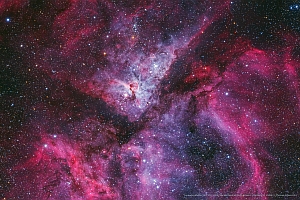Carina's Highlights is the topic of Part #5 of our image presentation, where we want to share the results from our astrophotography-trip to the Hacienda Los Andes in Chile.
Since the Milky Way runs through Carina, there is a large number of bright emission nebulae and open star clusters in this constellation. The first image shows the constellation Carina and in the upper left corner, you can see a part of the Milky Way with the Eta Carinae nebula, which is one of the largest diffuse nebulae in our sky. You can take images of Eta Carinae with all available focal lengths.
Moving south east from Eta Carinae, you can find NGC 3576, another interesting emission nebulae complex, which is also known as "The Statue of Liberty Nebula". Powerful winds from the nebula's embedded, young, massive stars shape the looping filaments of NGC 3576. Beside the emission nebulaes you can anlso find some nice refletion nebulaes like IC 2220 within the constellation-borders of Carina. IC 2220 - the Toby Jug Nebula - is formed by a big cloud of dust and gas, which is lit by the star HD 65750 - a red giant, that has five times the mass of our sun.
As mentioned before, you can also find some open star clusters in Carina. NGC 2516 is visible with the naked eye and was discovered by Abbe Lacaille in 1751-1752. Sometimes it is called "The Diamond Cluster" because of its stellar clarity and some other people call it "The Southern Beehive Star Cluster" because its appearance is similar to the Beehive Cluster (M44) visible in the northern hemisphere. Besides these highlights Carina contains also some rarely captured objects like a faint dwarf galaxy, which you can find on the last image of this series.









